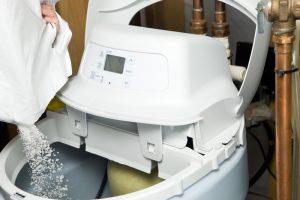Did you know that about 75% of homes in the US are affected by hard water? Hard water is not something that’s typically dangerous for your health. However, it does have a major downside for your pipes. Mineral deposits collect in plumbing systems and buildup to damage pipes, water heaters, faucets—even your coffee maker. But a water softener can help.
We hear a lot of misconceptions about the way these systems work. We want to give you a bit of information about this important home system so that your plumbing is as protected as possible. Contact us for more information.
It’s not like a standard water filter
When you picture a water filter, you probably imagine a media filter that traps particulate within a mesh or carbon layer. So why does a water softener require all that salt? Well, it works a lot differently than the air and water filters you may be used to.
Two large tanks and a set of valves and controls are needed to soften the water, which is much different than filtering the water. While water filters can trap many of the minerals in hard water, they are simply not as effective or as targeted as water softener systems.
Here are the components
There are two large tanks that make up a water softener system. The taller tank is the mineral tank, through which hard water initially enters the system. This tank is filled with small polystyrene beads—also called resin beads, which carry a negative charge. Minerals in hard water, which carry a positive charge, become attracted to these beads.
The second tank is filled with sodium ions (salt). This is called a brine solution. The brine is used to rinse the minerals from the resin so that more minerals can continue to be eliminated from the water supply. A computerized system is what typically allows for automated regeneration as needed to flush out the minerals.
Salt doesn’t exactly “replace” the minerals
We often hear that salt is there to “replace” the minerals in hard water, but this is not quite the case. The salt solution actually cleans out the resin beads, which need regular regeneration so they can continue to attract more mineral ions. The brine solution can then be flushed from the mineral tank, and more added as needed for proper regeneration.
Only professionals can install them
Of course, this guide does not offer all of the details about how a water softener works, and a system manual cannot tell you everything about installation and what can go wrong. It’s so important to call professional plumbers when you need a water softener installation, so you know that the right amount
A professional plumber can also guide you through proper maintenance of your new water softener, as all systems work a bit differently. We recommend keeping reliable plumbers on call for water softener installation, routine maintenance, and any repair needs you have, while keeping up on salt refilling yourself according to the plumber’s and manufacturer’s instructions.
Schedule service for your water softener in Tarpon Spring with the experts at Continental Plumbing Services, LLC.

